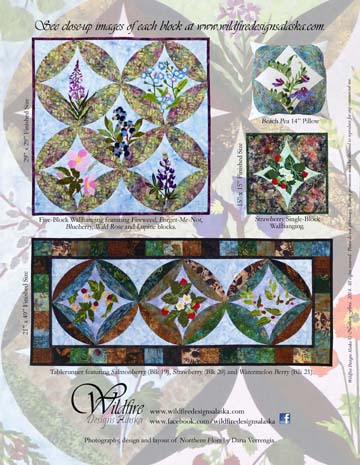The close up images of each block below show the blocks using their original batik print borders from the 2013 shop hop. The prints have been updated in the book and in currently available kits, however, all solid background and flora hand-dye colors remain the same as the original.
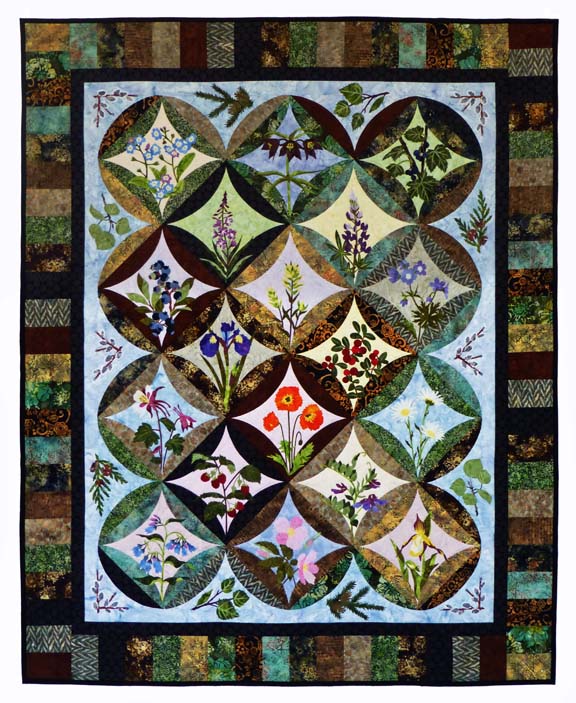
|
Northern Flora Book
Item #: WDA1401
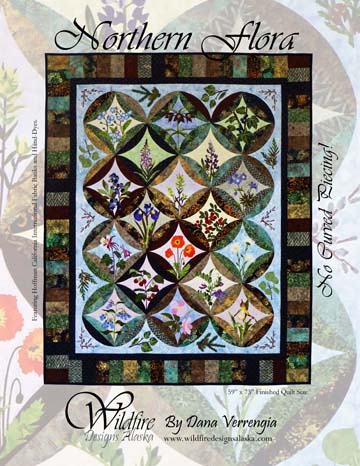
Video tutorials for assembling and fusing each laser cut block as well as the finishing and assembly available on my YouTube channel at www.youtube.com/@WildfireDAK
|
| The following images are close up views of the book cover and 21 individual Northern Flora applique blocks in the book. |
|
Northern Flora Book Cover
The Northern Flora book includes the instructions and appliques for the quilt and tablerunner, plus additional instructions for making a pillow, single-block wallhanging and five-block wallhanging using the flora block designs.
|
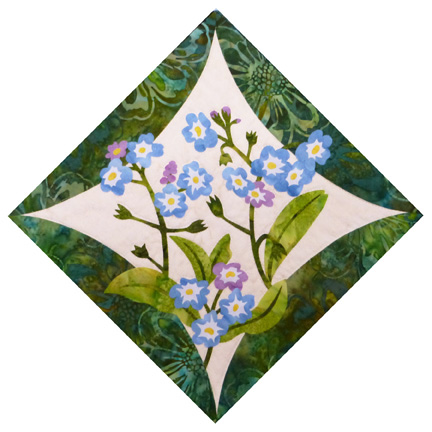 |
Block #1: Forget Me Not
Forget-me-nots are Alaska's State Flower. These tiny little flowers have over fifty species, and are found all over the world from the Americas to Europe to New Zealand. A German legend says that when God named all the plants, a little unnamed flower cried out, "Forget me not, O Lord." And God replied, "That shall be your name." |
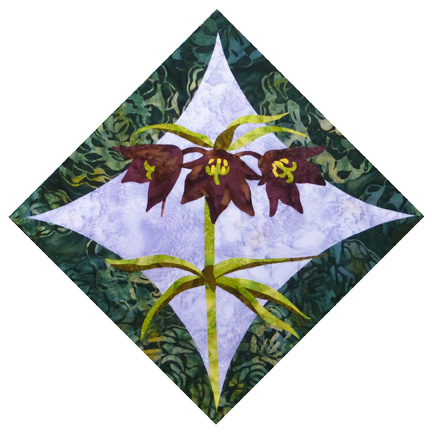 |
Block #2: Chocolate Lily
The Chocolate Lily grows all over Coastal Alaska, and as far south as Northern California, as well as Siberia, south to Japan. It is also called Indian Rice or Wild Rice because of the rice-like bulblets that form around its roots, which have been traditionally harvested by Native people of the North Pacific Rim for centuries. These bulbs are not only loved by many people, but often dug up by grizzly bears. It's name comes from its dark chocolate color. Unfortunately this lily doesn't smell like chocolate, and its foul odor has also given it the nickname of skunk lily and outhouse lily.
|
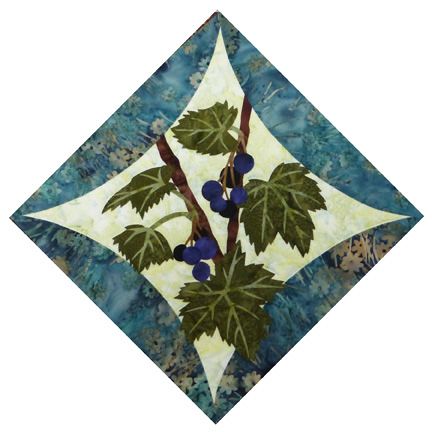 |
Block #3: Black Currant
Black Currants are found along the southern coastal regions of Alaska and across the northern United States, Europe and Asia. This berry was once banned by the United States Government for cultivation in the early 1900s because it carried a pathogen that could infect pine trees, and threatened the US logging industry. Hightly prized for its extraordinarily high Vitamin C content, as well as many other essential nutrients, it is used to make delicious jams, jellies, yogurt, sorbet, ice cream and even cheesecake.
|
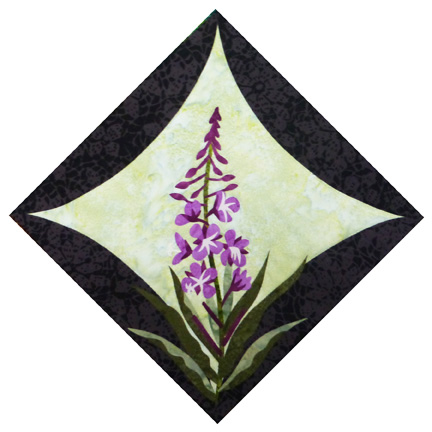 |
Block #4: Fireweed
Fireweed are probably one of the most visual and widely spread flowers in Alaska, and are found throughout the Northern Hemisphere. Growing from 1 1/2 to 9 feet tall, fireweed quickly take over recently burned forests and cleared fields. In the late Summer these beautiful flowers blanket the landscape turning open fields and mountainsides ablaze in pink. Fireweed blossoms are used to make candies, syrups, jellies and even honey. In the Fall the seeds are dispersed by the wind, and as the leaves begin to change color, these fields become a magnificent mix of gold and red.
|
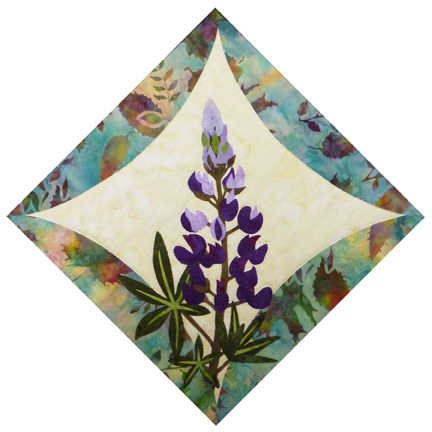 |
Block #5: Lupine
Over 83 species of Lupine grow around the world with over 1800 different regional names. These flowers grow in a range of colors from yellow to white, to pink, purple and blue. In Alaska at least three species of Lupine are found, the Large-Leafed, Nootka and Arctic; all of which produce purple blossoms. Lupines are one of the most attractive flowering plants in Alaska, seen blooming in fields, and along the roadways, from June to August. Belonging to the pea family, these lupines grow pods with pea-like seeds, but don't go adding these to your dinner menu, they're poisonous when eaten! |
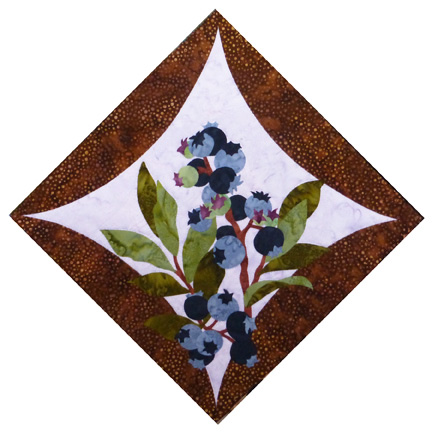 |
Block #6: Blueberry
Did you know that wild Alaska blueberries score double to triple the antioxidant power than cultivated varieties? There are many species of blueberries in Alaska, and are probably the most popular and favorite berry to pick in the Fall by local Alaskans. These naturally sweet barries are used in jams, jellies, syrups, pies, Indian Ice Cream and many other delicious delicacies - that is if they make it home without becoming an afternoon snack! |
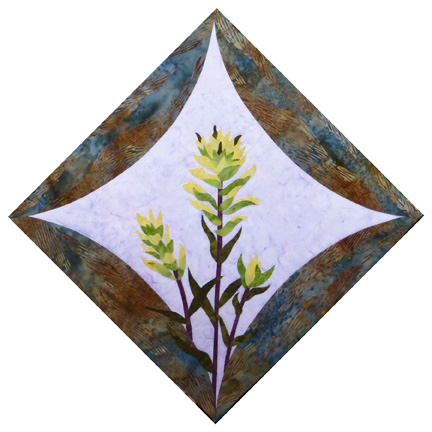 |
Block #7: Paintbrush
Around 200 species of Paintbrush are found throughout the Americas and northern Asia, nine of them in Alaska, including the pale yellow Coastal Paintbrush also known as the Alaska Indian Paintbrush. These flowers are actually partly parasitic, growing on the roots of other plants. Paintbrush colors range from yellow to orange to red, purple and pink.
|
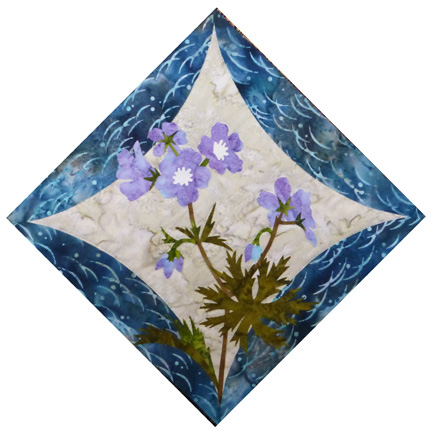 |
Block #8: Wild Geranium
Geranium is a genus of 422 species found throughout temperate regions of the world. Alaska Wild Geranium are found from British Columbia across the North Pacific Rim to Japan and China. These five-petaled lavender flowers are also known as Cranesbill, because their seed pods resemble a crane's bill before opening. The roots of the plant have been used by Native Alaskans to cure sore throat, and the leaves can be boiled as a tea.
|
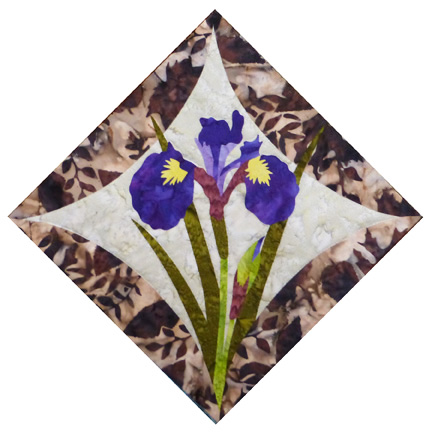 |
Block #9: Wild Iris
Wild Iris, also known as Wild Flag, are purple to bluish, and rarely white, flowers that grow wild in open meadows and subalpine areas of Alaska. The Iris genus has between 260 to 300 species across the Northern Hemisphere, and take their name from the Greek word for 'rainbow' due to the wide variety of flowering colors in the species. |
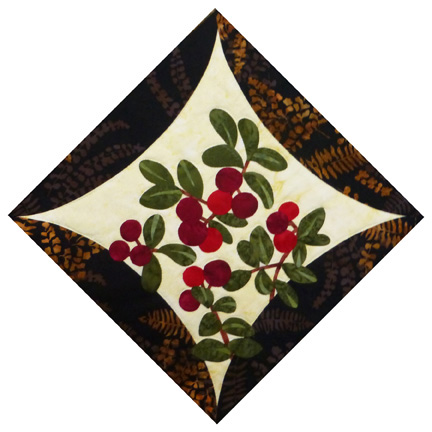 |
Block #10: Cranberry
The Lowbush Cranberry, native to boreal forest and Arctic tundra throughout Alaska and the Northern Hemisphere, are actually Vaccinium vitis-idaea, or Lingonberries. Lowbush Cranberry is one of at least twenty-five common names used to refer to the Lingonberry. Most Alaskans simply call these tart little red berries cranberries. Traditionally harvested by many Alaskan Native groups, these berries are also popular in traditional northern, central and eastern European cuisine. They are best picked after the first few frosts, when the berries are dark red, almost black, and at their sweetest. |
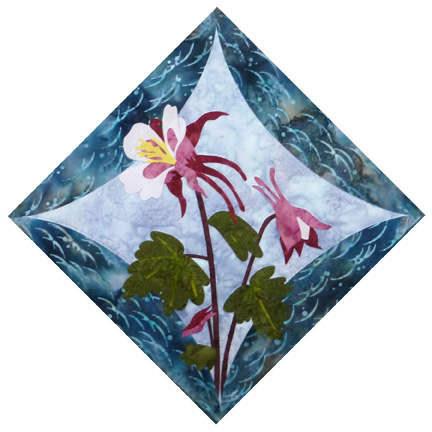 |
Block #11: Columbine
Columbine, also known as Aquilegia, is a genus of about 60 to 70 specias of wild flowers that grow at higher altitudes throughout the Northern Hemisphere. These flowers come in a wide range of colors from reds to pinks, purples, blues, yellows and whites. The name Aquilegia is derived from the Latin work for Eagle (Aquila), because of the shape of the flower petals, which are said to resemble an eagle's claws. The more common name of Columbine comes from the Latin word for Dove (Columba), due to the resemblance of the inverted flower to five doves clustered together. |
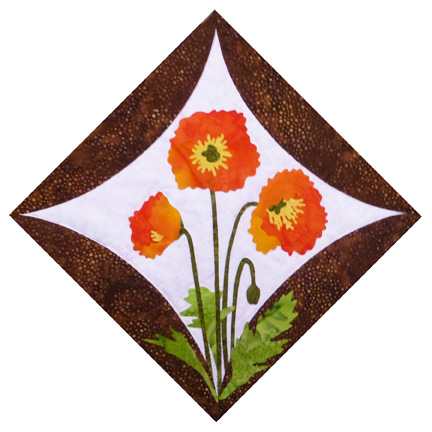 |
Block #12: Poppy
Poppies come in almost any color and are found around the world. In Alaska, they are typically yellow, pink, white or orange. Poppies have long been a symbol of sleep, peace and passing, and are sometimes used in rememberance of soldiers that have died during wartime. In the United States, artificial poppies called Buddy Poppies are used in the veterans' aid campaign by the Veterans of Foreign Wars, which assist veterans and their families. |
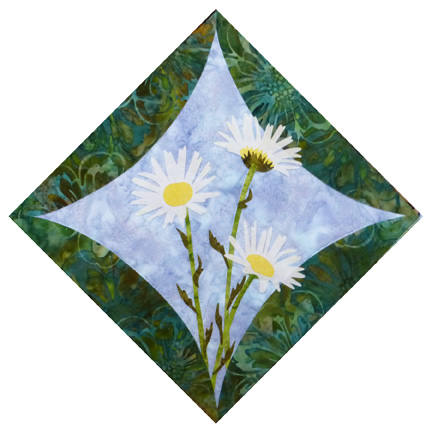 |
Block #13: Daisy
Daisies are part of the Asteraceae family, one of the largest and most widespread families in the world, comprising of more than 23,000 accepted species. They are found on every continent except Antarctica. This family includes flowers such as sunflowers, dahlias, marigolds and dandelions. The family name Asteraceae is derived from the Greek word aster, which means star. The name daisy, which widely applies to many members of this familly, comes from its Old English meaning dages eage meaning day's eye. This was because the petals of the flower opened at dawn and closed at dusk. |
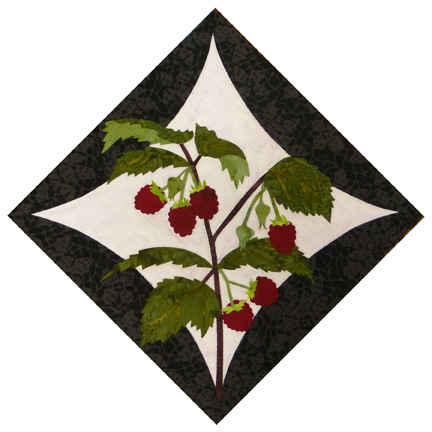 |
Block #14: Raspberry
American Red Raspberries are a species of Rubus, closely related to the European Raspberry, both of which are found throughout the temperate regions of the Northern Hemisphere. Though the name implies a berry, raspberries are actually botanically defined as a fruit. In Alaska these 'berries' grow in open fields, meadows, and in the shade of trees, producing small sweet fruit which are a local favorite for making jams, jellies, tarts and other yummy desserts - or eaten fresh as they're picked for a quick sweet snack! |
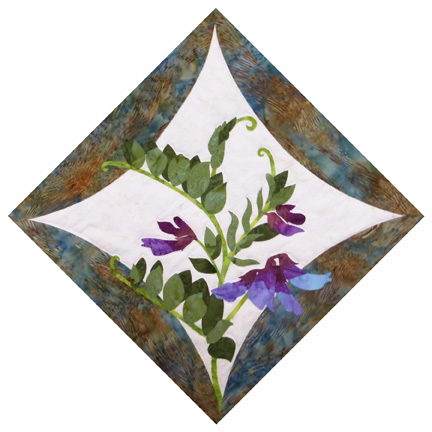 |
Block #15: Beach Pea
Beach Pea grow along beaches and coastal areas of Asia, Europe and North and South America. The pods of this plant have been traditionally harvested by coastal Native Alaska groups and can be eaten raw or boiled. The extensive range of this plant is due to the ability of the seeds to survive while floating in sea water for up to five years. Traveling worldwide, the seeds then germinate when the hard outer seed coat is scraped along rocks and sandy shores by the ocean's waves. |
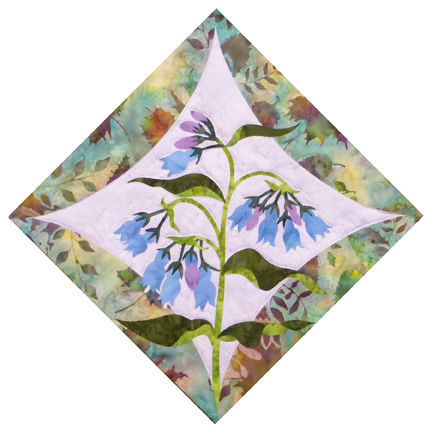 |
Block #16: Chiming Bells
Chiming bells are often found in Alaska in moist wooded or meadow areas. Also going by the names of Northern or Tall Bluebell, Tall Lungwort or the Languid Lady, these plants thrive within the temperate zones and boreal forests of northwestern North America and the Great Lakes. Growing to three feet tall, they produce clusters of periwinkle blue and lavender flowers throughout the summer that hang gracefully from the stock. |
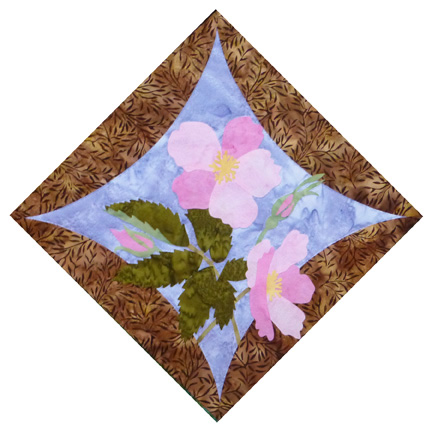 |
Block #17: Wild Rose
Two species of wild rose grow in Alaska, the Prickly Rose and the Nootka Rose. These two plants are very similar in appearance, and are often both referred to as simply a wild rose. Growing up to six feet tall with light to dark pink petals, the wild rose is one of the most loved wild flowers in Alaska. Bushes of wild roses are seen along the roadways and open areas in full blossom during the early summer. In the Fall, rose hips are collected and used to make jellies and butter, and the leaves and buds can be dried and used as tea. |
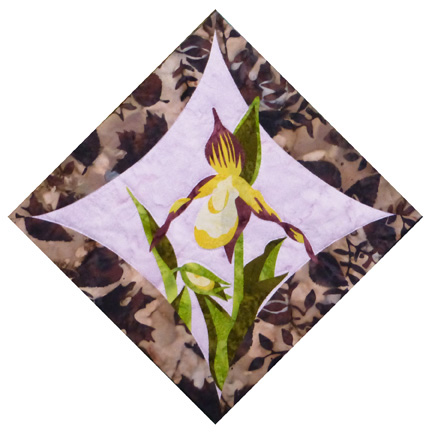 |
Block #18: Lady's Slipper
The Downy Lady's Slipper, also known as the Yellow Moccasin Flower, is characterized by its curiously twisted petals and slipper-shaped pouch. The pouch of the blossomed flower isn't only for looks, the shape traps insects inside so they are forced to climb up past the stamen, behind which they collect or deposit pollen, thus fertilizing the flower. Found wild in the Haines area in Alaska, it's range spreads across Canada and much of the northern United States, as well as Asia and Europe.
|
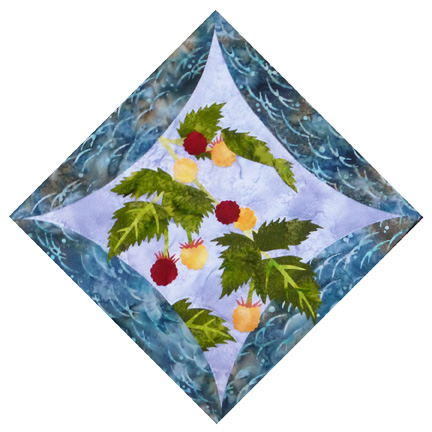 |
Block #19: Salmonberry
The Salmonberry is a member of the Rubus family native to the west coast of North America from Alaska to California. In the same family as the raspberry, the salmonberry produces large yellow to orange-red fruit from mid to late summer. In Kodiak, Alaska the orange salmonberries are often referred to as "Russian berries." Because of their similarity in appearance to raspberries, one of the islands in the Kodiak Archipelago was mistakenly named Raspberry Island, due to its many fields of salmonberries. The fruit of the salmonberry is often used to make jams, jellies, candy and even wine. |
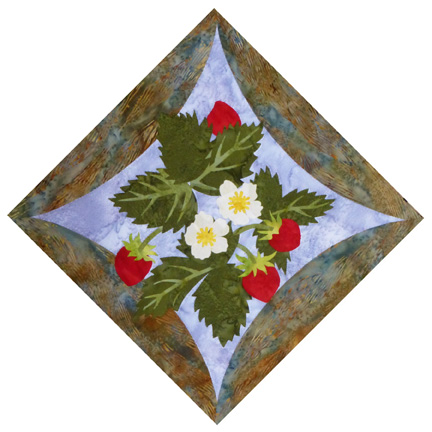 |
Block #20: Strawberry
The wild Strawberry, or Alpine Strawberry, grows throughout the northern hemisphere, in North America, Asia and Europe. Unlike many other wild fruits, the alpine strawberry flowers and fruits continuously throughout the summer creating multiple harvests each year. Not only are strawberries a favorite fruit of many people today, eaten fresh or for making jam, jellies and other sweet desserts, but evidence from archaeological excavations suggest that strawberries have been harvested for food as far back as the Stone Age. |
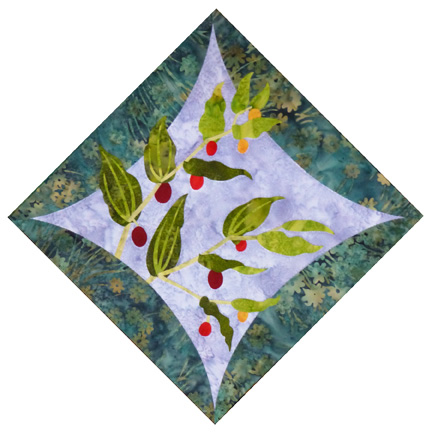 |
Block #21: Watermelon Berry
The Watermelon Berry, also known as Twisted Stalk or Wild Cucumber (due to its cucumber-like flavor), is widely distributed across much of North America, Europe and Asia. The bright green leaves on this plant make it easy to spot and have a distinctive kink at each leaf axil giving the plant's stem a 'twisted' appearance. The watery red oblong berries give it its locally common name of watermelon berry. |








